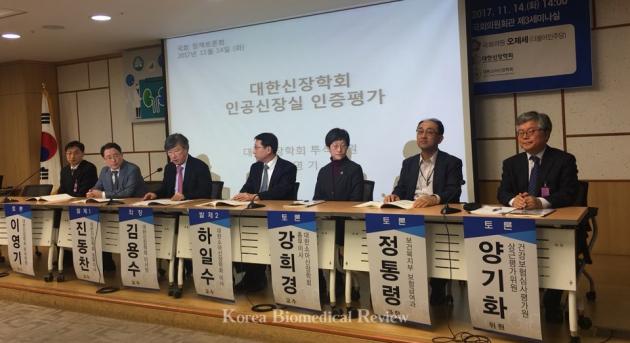The number of dialysis patients has been surging with population aging, as more and more people suffer from chronic diseases such as diabetes and hypertension in Korea. To ensure proper treatment and reduce costs, the government should designate dialysis as a “special disease” and directly manage dialysis patients, experts said Tuesday.
According to data from the Health Insurance Review & Assessment Service, the number of dialysis patients stood at 79,423 in 2015, and the total medical expense on them reached 1.98 trillion won ($1.77 billion). In 2009, when the government launched the state assessment on hemodialysis medical treatment, the number of dialysis patients was 56,896, and the total medical spending on them marked 1.24 trillion won. In seven years, the number of dialysis patients went up 28.4 percent.

The Korean Society of Nephrology, the Korean Society of Pediatric Nephrology, and Rep. Oh Je-se of the ruling Democratic Party held a forum on Tuesday at the National Assembly, to discuss the need to build a state system to manage dialysis patients.
“Patients suffering from an end-stage renal disease (ESRD) can die if they don’t receive hemodialysis, peritoneal dialysis, and kidney transplant. Among them, hemodialysis should be maintained for the rest of their lives,” said Jin Dong-chan, the KSN’s director of ESRD registry committee. “According to ESRD registry committee’s data, the number of hemodialysis patients amounted to more than 70,000 as of late 2016. Their growth has been especially fast since 2010, compared to those who received a kidney transplant or peritoneal dialysis.”
While Korea’s prevalence of dialysis is almost as high as the world’s top two --Japan and the U.S. -- Korea’s rate of dialysis patients surviving for more than five years remains low at around 60 percent, which is lower than cancer survival rate, Jin noted.
“A rapid growth of dialysis patients will push the number to 100,000 soon. An annual cost for dialysis is around 30 million won per patient. To ensure patients receive proper dialysis and to reduce the state’s medical expense, the government should take care of registering and managing dialysis patients,” he added.
Since 1985, the KSN has been managing the registration of ESRD patients and certifying dialysis specialists. However, the society is now overstretched, and the government should build a state management system instead, Jin said.
In the U.S., the National Institutes of Health registers information about dialysis patients across the U.S. and updates latest information on the disease and treatment methods in every November.
Jin suggested the government create an integrated information center for dialysis patients and have HIRA and the Korean Society of Nephrology jointly run the center to register patient information and share related data.
“Based on the patient information, medical institutions can check treatment results so that they can avoid unnecessary exams and misdiagnosis. Based on shared data, the HIRA will be able to conduct assessments on related medical service and make reasonable medical payments,” he said.
The Ministry of Health and Welfare and the HIRA expressed a positive view on Jin’s suggestion.
“Next year’s assessment to manage the quality of hemodialysis will be the sixth. From 2018, the assessment period will be extended from three months to six months with a wider spectrum of evaluation,” said Yang Ki-hwa, a member of the HIRA’s evaluation committee. “If we can register dialysis patients to an integrated center and manage them, we will be able to check if they are getting proper treatments. Then, we will be able to overcome the current issue where we cannot reflect the outcomes of dialysis.”
It would be good for the HIRA to conduct the assessment along with the patient registration, but there is no legal ground for the agency to register and manage dialysis patients directly, Yang pointed out.
A state management system would also need incentives to encourage nursing homes to put patient data into the integrated center, he added.
A government official agreed in principle. “As the HIRA’s reviews and assessments are increasingly based on medical records rather than on claims data, it will be desirable to reflect various patient data, earned from patient registrations (at a state center), and help hospitals voluntarily improve medical service quality,” said Chung Tong-ryeong, director of the Insurance Payment Division at the Ministry of Health and Welfare.

